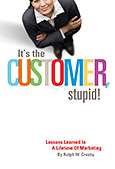Spread Your Marketing Message Person To Person
Many years ago, in my first career as a journalist, I published a book, Person-To-Person Management, in which I postulated that the business revolution brought on by technology would not change the need of management and marketing to be “person-to-person.”
Back then, I wrote, “In the revolution, when the human hand seems most likely to lose its grip, the personal touch has pointed the way to success.”
Written before the advent of the Internet, that was prescient. In marketing today, when we laud campaigns for “going viral,” we mean they’re spreading from “person-to-person,” expanding through their own momentum.
“Viral marketing” is most associated with social networking today. Social networks, such as Facebook and Twitter, harken back to the most basic – and probably the most effective – form of marketing, word-of-mouth. You can share content with your online friends, and they can share that content with their friends, thereby becoming proponents for you. That’s viral marketing at its best, where your message gets passed on from person to person.
While social media is the key driver of viral marketing, it does not work alone. You can’t rely solely on social media to get your message to your customer. The traditional media – print, TV, outdoor and PR – remain an important part of moving customers to action, especially if you want them to find your offerings online. This is why my marketing mantra has become “New media plus old media equals the future of marketing.”
I like to use the example of Susan Boyle to demonstrate the concept. This dowdy, unassuming woman, from a tiny town in Scotland, appeared on the reality show “Britain’s Got Talent” and shocked the judges and the audience with her gifted voice. Her performance went viral on the Web, producing millions of hits and making Ms. Boyle a celebrity and commercial success. This event also showed the uncommon value of the marriage between offline and online media, as reported in the Washington Post:
“To media observers, the speed and scope of Boyle’s online ubiquity is a testament that the marriage between old media (her performance first aired on British television) and new media (it then made its way to YouTube, Twitter, and Facebook) is broadening the reach of all media, from one channel to another, from person to person.”
Thanks to the Post for supplying the definition of where I believe marketing has gone: “The marriage between old media and new media is broadening the reach of all media, from one channel to another, from person to person.”
###

 Businesses often are started by entrepreneurs with an idea, a product or service, or an expertise. Many of them fail, not because the idea or product isn’t good, but because their attention is overwhelmingly directed internally – e.g., what goes into the product – when they should focus externally, always reminding themselves:
Businesses often are started by entrepreneurs with an idea, a product or service, or an expertise. Many of them fail, not because the idea or product isn’t good, but because their attention is overwhelmingly directed internally – e.g., what goes into the product – when they should focus externally, always reminding themselves:
